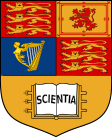St Mark's Hospital
| St Mark's Hospital, The National Bowel Hospital | |
|---|---|
| London North West University Healthcare NHS Trust | |
 St Mark's Hospital | |
Location within Brent | |
| Geography | |
| Location | Acton Lane, London NW10 7NS, Greater London, England, United Kingdom |
| Coordinates | 51°31′51.879″N 0°16′8.718″W / 51.53107750°N 0.26908833°W |
| Organisation | |
| Care system | Public NHS |
| Type | Specialist |
| Affiliated university | Imperial College London |
| Services | |
| Emergency department | No Accident & Emergency |
| Beds | <40 |
| Speciality | Intestinal and Colorectal medicine |
| History | |
| Opened | 1835 |
| Links | |
| Website | www |
| Lists | Hospitals in England |
St Mark's Hospital, The National Bowel Hospital (informally St Mark's) is a hospital in
The Main Hospital is at the Central Middlesex site in Acton Lane, London, located in the most southerly part of the London Borough of Brent. It has two other hubs, one is St Mark's at Northwick Park situated within Northwick Park Hospital in Harrow and the other is St Mark's at Ealing situated within Ealing Hospital. St Mark's is closely associated with Imperial College London and is a major centre for teaching and research.
History
Beginnings
The beginnings of St Mark's Hospital were in a small room at No 11
Much of the financial support came from the City of London. The Lord Mayor,
The staff consisted of a surgeon, a Matron, a dispenser, nurses and servants. St Mark's was unique in not employing a physician until 1948, with the arrival of
New St Mark's
By the 1870s, ever-increasing demands on the Hospital caused rebuilding to be considered. The adjacent site, occupied by rice mills, was acquired but could not be developed for some years due to lack of funds. Eventually, building began and in January 1896 the 'New St Mark's' was opened. There was considerable difficulty in meeting the costs of maintaining the new building and it was the entertainment industry that finally came to the rescue.
1972 to present
The hospital was administered jointly with
References
- ^ St. Mark's Hospital ∞ Welcome to St Mark's Hospital
- ^ "Britain's best hospitals: A patients' guide". The Independent. 20 March 2008. Archived from the original on 24 May 2022. Retrieved 3 June 2011.
- ^ a b c d e f g h i j "St. Mark's Hospital". Lost hospitals of London. Retrieved 19 May 2018.
- ^ a b c "Home". Cancerworld. Retrieved 19 May 2018.
- ^ a b c AIM25: St Bartholomew's Hospital: St Mark's Hospital
- ^ Sir Francis Avery Jones • Arthur Milton Bowler • Arthur Moreland Brown • Richard Morris Butler • Alistair Hugh Cameron • Peter Bruno D'Souza • James William Fawcett • Lionel Travers ("Leo") Martin • Elspeth Marguerita Whittaker Stokes • Verna Wright • Philip Metcalfe Yeoman – Baron et al. 316 (7145): 1678 – BMJ


